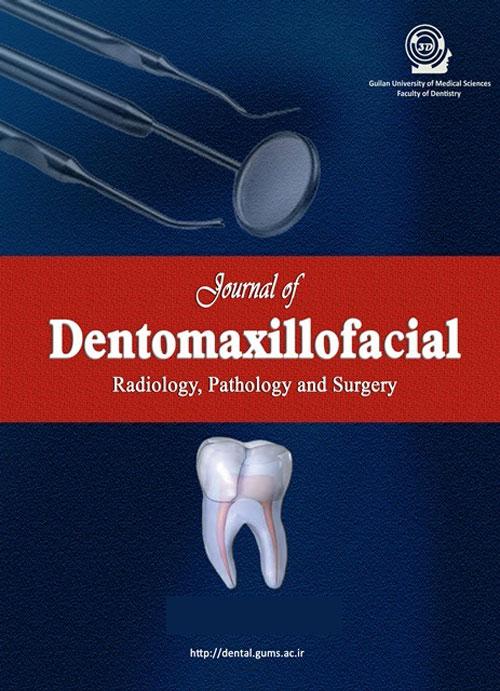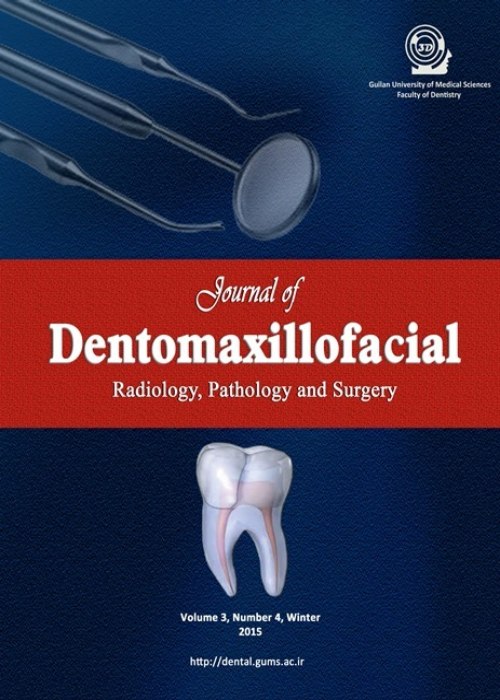فهرست مطالب

Journal of Dentomaxillofacil Radiology, Pathology and Surgery
Volume:3 Issue: 1, Spring 2014
- تاریخ انتشار: 1393/03/01
- تعداد عناوین: 6
-
-
Pages 1-5IntroductionMedical emergencies can frequently happen in dental settings and inability to cope with them can lead to tragic outcomes. The of aim of this study was to evaluate the occurrence of medical emergencies in dental settings in Babol, Iran and dentists’ self-perceived need for practical training in this field.Materials And MethodsA descriptive-ana-lytical study was performed by using a questionnaire containing questions about the frequency of medical emergencies during the previous year and dentists’ self-perceived need for training to manage these cases. Data were analyzed by SPSS 18.0. Chi-square and t–test were used to evaluate the correlation between the variables. P<0.05 was considered statistically significant.ResultsOne hundred and twelve (84%) dentists answered the questionnaire. Collectively, 19 emergency cases were experienced by 17 dentists during the last year. The most prevalent emergency was vasovagal syncope(47%) and the least was anaphylactic shock(10%). One hundred and two dentists felt the need for practical training in medical emergencies. The need was perceived more by women, general dentists and those with more than 10 years occupation. But the correlation between sex, degree of education and duration of occupation and self-perceived need for training was not significant (p>0.05).ConclusionVasovagal syncope was the most prevalent emergency in dental settings. Most of the respondents were in favor of continuous education regarding the practical training in management of medical emergency.Keywords: Emergency Medical Services, Dentists, Education
-
Pages 6-14IntroductionSquamous Cell Carcinoma (SCC) is the most common head and neck malignancy. To decrease the side effects of treatment and mortality from disease relapse, careful staging for the proper treatment plan is necessary. The main purpose of this prospective study is to compare the diagnostic value of Computed Tomography (CT) and Magnetic Resonance Im-aging (MRI) in oral SCC and its lymph node me-tastasis in order to represent the proper treat-ment plan.Materials And Methods30 patients (19 men and 11 women) with oral SCC underwent CT and MRI before surgery. Imaging modalities of each study were evaluated individually for tu-mor size, bone invasion, muscle infiltration. These evaluations were done by two radiolo-gists and an oral-maxillofacial surgeon and veri-fied with histopathology findings as gold stand-ard. The results of the radiological assessment were correlated with the intraoperative and histopathological findings in all patients.ResultsCT and MRI have equal potential for detecting the tumor size, perineural invasion and nodal metastasis. The sensitivity and spe-cificity were 50%, 90% for CT in the detection of bone invasion and 90%, 85% for MRI. The sensi-tivity and specificity were 66.66%, 90.47% for CT in detection of muscle infiltration and 55.55%, 90.47% for MRI.ConclusionThe comparison of these modalities showed no statistically significant difference between CT and MRI. Regarding bone infiltra-tion the sensitivity of CT scan was higher than of MRI, but regarding muscle invasion the spe-cificity of MRI was higher than of CT scan.Keywords: Carcinoma, Squamous Cell, Lymph Nodes, Neoplasm Metastasis, Magnet, ic Resonance Imaging
-
Pages 15-22IntroductionThe image quality as well as film speed is influenced by the film processing conditions. Different combinations of films and processing methods affect the diagnostic accu-racy. Temperature and developer exhaustion result in different image quality. The purpose of this study was to evaluate the influence of film type and processing conditions on caries detec-tion.Material And MethodsEighty proximal surfaces in forty extracted unrestored premolars were radiographed under standardized conditions using D and F speed Flow Dental intraoral films. The exposure time was reduced by 50% for F-speed films. Half of the samples in each group were processed manually while the others automatically. No replenishment was used and the temperature was kept constant during the procedure. True caries diagnosis was based on histological assessment of the surfaces after sectioning the teeth. Two observers read the radiographs using a four-point scale to record their diagnosis. Observers'' responses were evaluated using repeated measures analysis of estimation error.ResultsNo significant differences were found in the diagnostic efficiency between two films and two processing methods in fresh and exhausted processing solution. F-speed(FV-58), however, showed earlier loss of diagnostic efficiency than D-speed(DV-58). Differences between observers were also not statistically significant.ConclusionThe performance of the new F-Speed film(FV-58) was not statistically different from D-Speed for caries detection under differ-ent processing condition, and could be recom-mended for using in dental practice contributing to dose reduction.Keywords: Dental caries, Diagnosis, Radiography, X-ray
-
Pages 23-28IntroductionPermanent first molar is the most important unit in the chewing system. Ear-ly loss of first molars can significantly reduce chewing efficiency, increase overbite, lead to premature eruption of the permanent second and third molars, and displacement of adjacent teeth. The purpose of this study was to determine the associated factors of permanent first molar caries in 7-9 years old children in Rasht, in 2014.Materials And MethodsThis cross-sectional comparative study was performed on 190 child-ren 7 to 9 years old. Examination was carried out by one examiner in the pediatric depart-ment, with disposable mirror and explorer and under the light of dental unit. A self-adminis-tered questionnaire was completed by parents before the examination, containing an informed consent, demographic data and information about tooth brushing and dietary habits. Data were statistically analyzed using independent t-test and chi-square tests.ResultsThere was a significant relationship between the permanent first molar caries and dmft index (p = 0.001), mean plaque index (p = 0.001), consumption of between meal snacks three times a day (p = 0.046), using of sugar-containing drinks before bedtime (p = 0.048) and the age tooth brushing had started (p=0.027). There was no significant association between socio-demographic factors, frequency and method of tooth brushing and the perma-nent first molar caries.ConclusionHigh dmft and plaque index, con-sumption of between meal snacks and using sugary drinks before sleep increases the risk of permanent first molar caries.Keywords: Dental Caries, Dental Plaque, DMF Index, Molar
-
Pages 29-36IntroductionOral Candidosis is among the find-ings of acute leukemia. The aim of this study was to evaluate the changes in the intensity of C.albicans, before treatment and at the Induc-tion phase.Materials And MethodsTwelve patients with Acute Lymphoblastic Leukemia (ALL) aged 2-14 years enrolled in study. Whole Saliva samples were obtained and cultured to determine the mean count of C.albicans Colony Forming Units (CFU) before induction of leukemia, and at days 35 and 64 of induction. White blood cell counts were also determined at the same time. Data were transferred to SPSS 19 and analyzed using paired and Independent t-test, Chi square, and stepwise regression.ResultsThe mean CFU count was significantly increased before beginning of the treatment [22.41±10.47] to days 35[28.5±9.29] (P=0.006) and 64 of induction[30.5±11.82] (P=0.009) an-dat the first day of consolidation [49.66±3.01] (P=0.032).The quantity of colonies was sparse (10-100 CFU/ml) without clinical manifestations of oral candidiasis. Main predictors of C.albicans colonization were age and white blood cell count (WBC). Children younger than age 10 yrs (OR=-19.7, 95% CL [12.37-15.82 for day 35 eval-uation] and (OR=-0.002, 95% CL[-0.004-0.00 inday 64]and those with lower WBC (OR=-13.47, 95% CL [-25.29 -1.65]) showed higher risks of colonization.ConclusionC.albicans colonization was ob-served among the leukemia child patients at early phase of treatment without clinical mani-festations. The predictors of colonization were age and white blood cell counts.Keywords: Acute Lymphoblastic Leukemia, Candida albicans, Child
-
Pages 36-47IntroductionIt was to compare the efficacy of semiannually fluoride varnish application versus pit and fissure sealant to reduce occlusal caries incidence.Materials And MethodsA randomized parallel designed study was conducted with 352 child-ren aged 6-7 years. Participants were allocated into biannual application of varnish (n=179) (NaF 5 %(Durafluor, DENTSPLY®, Latin America) or resin-based fissure sealant (n=173) (Eco Seal, Korea®) single application without previous tooth preparation. Two visual-tactile methods including WHO and Nyvad criteria were used for caries detection. The unit of analysis was tooth surface. χ2 test, t-test, Fisher exact, and multi-variable logistic regression were used for statis-tical analysis.ResultsProportion of caries free (DMF=0) were 79.8% and 79.1% among the sealant and var-nish groups respectively. By using Nyvad visual-tactile criteria 60.4% and 50.2% of surfaces re-mained sound in sealant and varnish groups respectively (p < 0.001). The prevented fraction of sealant to varnish by two measures was 3.46 and 20.5 respectively. Regression model showed sealant application (OR=0.34) and tooth brushing >2 times/day (OR=0.8) were protective factors while dmfs>4(OR=0.08), and snack con-sumption >2 times/day (OR=1.3) were risk fac-tors of caries incidence.ConclusionThe results of this study suggest that semiannual fluoride varnish application can be recommended for preventing and reducing occlusal caries in low caries risk population.Keywords: Fluoride varnish, Fissure sealant, Occlusal Caries


